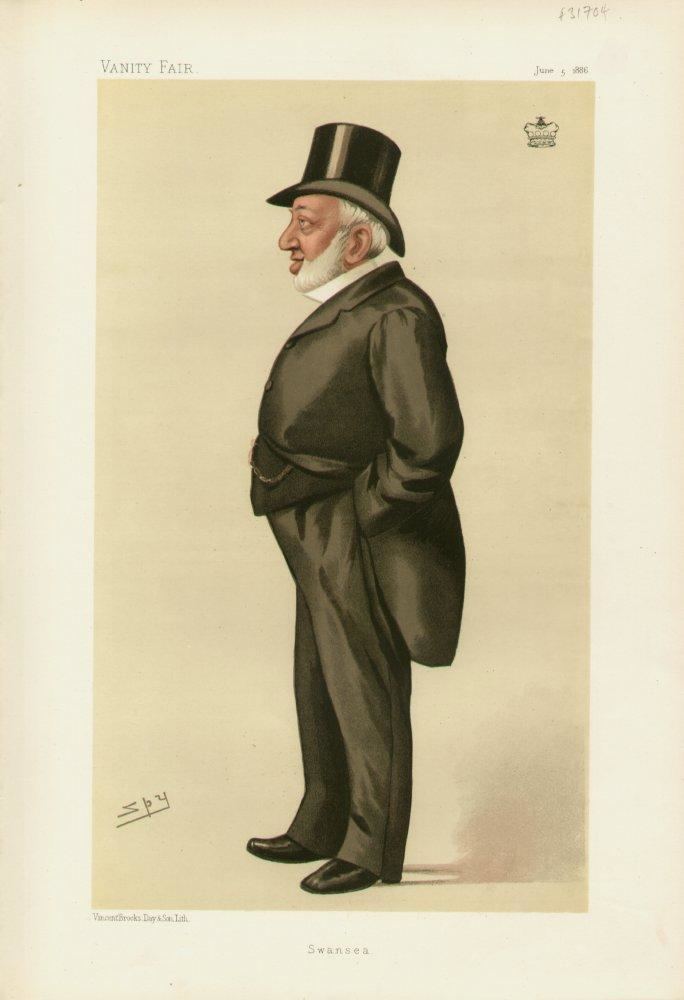Preceded by Humphrey Willyams Name Henry 1st Succeeded by Abolished Role Politician | Resigned 1857 | |
 | ||
Books Notes of a tour in America | ||
Henry Hussey Vivian, 1st Baron Swansea (6 July 1821 – 28 November 1894) was a Welsh industrialist and politician from the Vivian family.
Contents
Biography
Born at Singleton Abbey, Swansea, Henry was the eldest son of industrialist and MP John Henry Vivian and his wife Sarah, daughter of Arthur Jones, of Reigate. His younger brothers were Arthur Vivian (who would become an industrialist and MP), Richard Glynn Vivian (afterwards an art collector and philanthropist) and Graham Vivian. His uncle was Richard Hussey Vivian, first baron Vivian. He was educated at Eton and studied metallurgy in Germany and France from 1838 before entering Trinity College, Cambridge in 1839.
After two years he became manager of the Liverpool branch of the copper-smelting business founded by his grandfather, Vivian & Sons. Three years later he became a partner of the firm before coming to Swansea to manage the Hafod Works during the last ten years of his father’s life (1845–1855). He developed a range of by-products from copper-smelting and diversified into other metallurgical activities. He is credited with originating the "sliding scale" of miners' wages after the strike of 1889, though other authorities attribute the idea to William Thomas Lewis, afterwards Lord Merthyr. He was one of the chief promoters of the Rhondda and Swansea Bay Railway, helped to further extend the harbour facilities of the town and championed the merits of Welsh coal in Parliamentary debates. It was largely due to his efforts that Swansea became a major industrial centre.
He served as a Member of Parliament (MP) for Truro 1852–7, Glamorganshire 1857–85 and Swansea District 1885–93. In 1889 he became the first chairman of the Glamorgan County Council. He was also a Justice of the Peace, Deputy Lieutenant for Glamorgan and for some years first Lieutenant-Colonel of the 4th Glamorgan Rifle Volunteers.
He was created a baronet of Singleton in the Parish of Swansea in the County of Glamorgan on 13 May 1882 and Baron Swansea, of Singleton in the County of Glamorgan on 9 June 1893.
After his death on 28 November 1894, probate was granted to his sons Henry Hussey Vivian and Odo Richard Vivian valuing his estate at £163,707 1s 9d, he was buried in the churchyard of St Paul's Church in Sketty. There is a bronze statue of Henry wearing a frock coat and gown in St. David's Shopping Centre, Swansea, created by Italian sculptor Mario Raggi. There is also a plaque at St John's Church in Hafod. It was erected by his widow and contains the words 'Life's race well run. Life's work well done. Life's crown well won. Then comes rest'.
Lord Swansea's younger brother Sir Arthur Vivian was also a Liberal politician.
Marriages and children
Lord Swansea married, on 15 April 1847, to Jessie Dalrymple Goddard (c. 1825 – 28 February 1848), the daughter of Ambrose Goddard, of the Lawn, Swindon. His wife died of childbed fever a few weeks after the birth of their only child.
On 14 July 1853 he married Lady Flora Caroline Elizabeth Cholmeley (died 25 January 1868), daughter of Sir Montague Cholmeley, 2nd Baronet. They had one son;
Lord Swansea took as his third wife, on 10 November 1870, Averil Beaumont (1841 – 14 January 1934), daughter of Capt. Richard Beaumont, R.N., and granddaughter of the 3rd Baron Macdonald of Slate. He and his third wife had six children;
